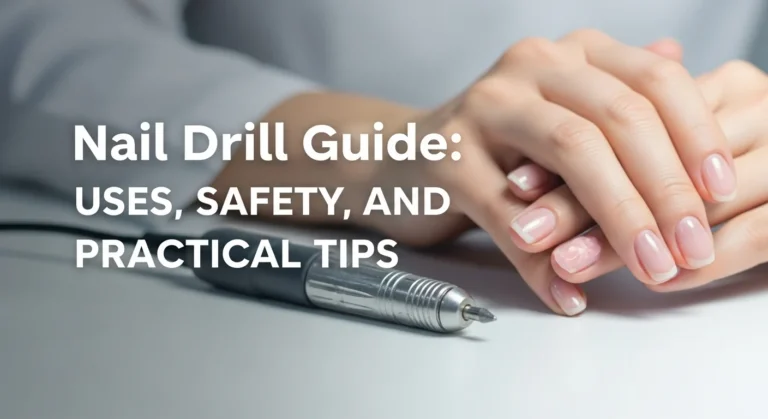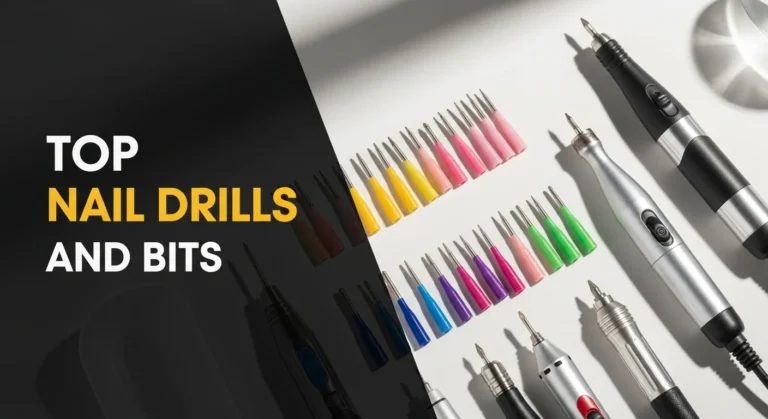How to Choose the Perfect Nail Drill Bit for Every Nail Art Goal
Selecting the right nail drill bit depends on your specific nail art goal, whether shaping, cuticle work, or enhancement removal. By understanding bit materials, grits, and techniques, you can achieve precise results while protecting nail health. Always refer to your drill’s manual for compatibility and consider professional training for advanced applications.
Nail drill bits are specialized attachments for electric nail drills, designed for tasks like shaping, smoothing, or removing enhancements. Selecting the right bit is crucial for achieving specific nail art goals while maintaining nail health.
Check more Nail Drill Guide: Uses, Safety, And Practical Tips
1. What Are Nail Drill Bits and Why Do They Matter?
Answer: Nail drill bits are tools attached to a nail drill, each designed for specific tasks like filing, cuticle work, or product removal.
Nail drill bits vary in material, shape, and grit, impacting their function and safety. Choosing the appropriate bit ensures precision, prevents damage, and supports your nail art objectives, such as creating smooth surfaces or intricate designs.
- Materials: Common materials include carbide, diamond, ceramic, and sanding bands, each suited for different tasks.
- Shapes: Shapes like cone, barrel, or needle affect precision and surface area coverage.
- Grit: Measured as coarse, medium, or fine, grit determines how aggressive the bit is.
Table: Common Nail Drill Bit Materials
| Material | Durability | Best For |
|---|---|---|
| Carbide | High | Removing gel/acrylics |
| Diamond | High | Cuticle work, edge smoothing |
| Ceramic | Moderate | Smoothing natural nails |
| Sanding Bands | Low (disposable) | Shaping, surface prep |
2. Which Bit Should I Use for Shaping Nails?
Answer: Sanding bands or medium-grit carbide bits are ideal for shaping natural or artificial nails.
Shaping involves adjusting nail length or creating specific shapes like almond or square. The bit must file efficiently without excessive heat or pressure.
- Sanding Bands: Disposable, easy to use, available in coarse (80 grit) to fine (240 grit). Best for beginners shaping natural nails.
- Carbide Bits (Barrel Shape): Durable, medium grit (120–180) for shaping acrylics or gels. Use at 10,000–15,000 RPM.
- Safety Tip: Work in short bursts (2–3 seconds) to avoid thinning the nail plate.
Table: Shaping Bit Options
| Bit Type | Grit | RPM Range | Best Nail Type |
|---|---|---|---|
| Sanding Band | 80–240 | 5,000–15,000 | Natural nails |
| Carbide (Barrel) | 120–180 | 10,000–15,000 | Acrylics, gels |
3. What’s the Best Bit for Cuticle Work?
Answer: Diamond bits with fine grit are best for safe, precise cuticle cleanup.
Cuticle work requires precision to remove dead skin or prep for nail art without damaging the nail bed or surrounding skin.
- Diamond Bits (Cone or Flame Shape): Fine grit (240–320) for gentle cuticle removal. Use at 7,000–12,000 RPM.
- Technique: Hold the drill at a 45-degree angle and use light, sweeping motions.
- Caution: Avoid coarse bits, which can cut skin or over-file the nail base.
4. Which Bit Is Best for Removing Gel or Acrylic?
Answer: Carbide or ceramic bits with medium to coarse grit are effective for removing gel polish or acrylic enhancements.
Removing enhancements requires a bit that can file through hard materials without overheating the nail.
- Carbide Bits (Barrel or Cone): Medium to coarse grit (100–150) for quick removal. Use at 15,000–20,000 RPM.
- Ceramic Bits: Less heat buildup, medium grit (120–180) for gentler removal. Suitable for sensitive nails.
- Safety Tip: File in layers, pausing to check progress, to avoid damaging the natural nail.
Table: Removal Bit Options
| Bit Type | Grit | RPM Range | Best For |
|---|---|---|---|
| Carbide | 100–150 | 15,000–20,000 | Acrylics, hard gels |
| Ceramic | 120–180 | 12,000–18,000 | Gel polish, sensitive nails |
5. How Do I Choose Bits for Nail Art Details?
Answer: Fine-grit diamond or needle-shaped bits are ideal for intricate nail art tasks like etching or 3D designs.
Detailed nail art, such as carving patterns or prepping for embellishments, requires precision and control.
- Diamond Bits (Needle or Small Cone): Extra-fine grit (320+) for etching designs or cleaning under nail tips. Use at 5,000–10,000 RPM.
- Technique: Work slowly with minimal pressure to maintain control.
- Tip: Practice on a plastic nail tip to perfect your technique before working on real nails.
6. How Do I Ensure Bit Compatibility with My Drill?
Answer: Check your drill’s shank size and RPM range to ensure bit compatibility.
Most nail drills use a standard 3/32-inch shank, but RPM compatibility varies. Using an incompatible bit can damage the drill or reduce effectiveness.
- Verify Shank Size: Measure the bit’s base or check the drill’s manual. 3/32-inch is standard for most home and salon drills.
- Check RPM Range: Ensure the bit’s recommended RPM matches your drill’s capabilities (e.g., 5,000–35,000 RPM for professional models).
- Inspect Wear: Replace bits showing signs of dullness or damage to maintain performance.
7. How Do I Maintain and Clean Drill Bits?
Answer: Clean and sanitize bits after each use to ensure hygiene and longevity.
Proper maintenance prevents bacterial buildup and ensures bits perform effectively.
- Brush Off Debris: Use a soft brush (e.g., a clean toothbrush) to remove dust and residue.
- Sanitize Metal/Ceramic Bits: Soak in a salon-grade disinfectant for 10 minutes, following product guidelines.
- Dispose of Sanding Bands: Replace after each use, as they are not reusable.
- Store Properly: Keep bits in a dry, organized case to prevent damage or rust.
Additional Considerations
- Nail Health: Always monitor for signs of over-filing, such as redness or thinning, and pause use if detected. Apply cuticle oil post-drilling to hydrate.
- Bit Quality: Choose bits from reputable suppliers to ensure durability and safety. Check user reviews on platforms like X for feedback.
- Learning Curve: Experiment with bits on practice nails to build confidence. For more guidance, explore our nail drill guide (hosted on a sandbox site for testing—avoid entering personal information).




